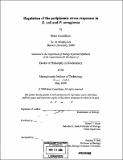Regulation of the periplasmic stress responses in E. coli and P. aeruginosa
Author(s)
Cezairliyan, Brent (Brent O.)
DownloadFull printable version (11.79Mb)
Other Contributors
Massachusetts Institute of Technology. Dept. of Biology.
Advisor
Robert T. Sauer.
Terms of use
Metadata
Show full item recordAbstract
The ability to adapt to changing environments is essential to survival. Bacteria have developed sophisticated means by which they sense and respond to stresses imposed by changes in the environment. I have undertaken the study of elements of the TE stress response pathway in the bacterium Escherichia coli and the orthologous pathway in the bacterium Pseudomonas aeruginosa. These pathways sense stress in the periplasm and relay the signal into the cytoplasm by a series of proteolytic cleavages of a transmembrane regulatory protein. In E. coli, I have undertaken the study of the regulation of the cleavage of transmembrane regulator RseA by the first protease, DegS. I discovered that RseB, an RseA-binding protein, inhibits cleavage of RseA by DegS. The interaction between RseA and RseB is strong and specific, and the inhibition of cleavage is independent of the autoinhibition of DegS by its PDZ domain. In P. aeruginosa, I have demonstrated that AlgW, the homolog of DegS, cleaves the transmembrane regulator MucA. I have shown similar inhibitory effects of the ortholog of RseB on the ortholog of RseA. Interestingly, the PDZ domain of AlgW appears to function differently from that of DegS. In addition, I observed that a regulatory loop in the AlgW protease plays an inhibitory role in the binding of substrate.
Description
Thesis (Ph. D.)--Massachusetts Institute of Technology, Dept. of Biology, 2008. Includes bibliographical references.
Date issued
2008Department
Massachusetts Institute of Technology. Department of BiologyPublisher
Massachusetts Institute of Technology
Keywords
Biology.